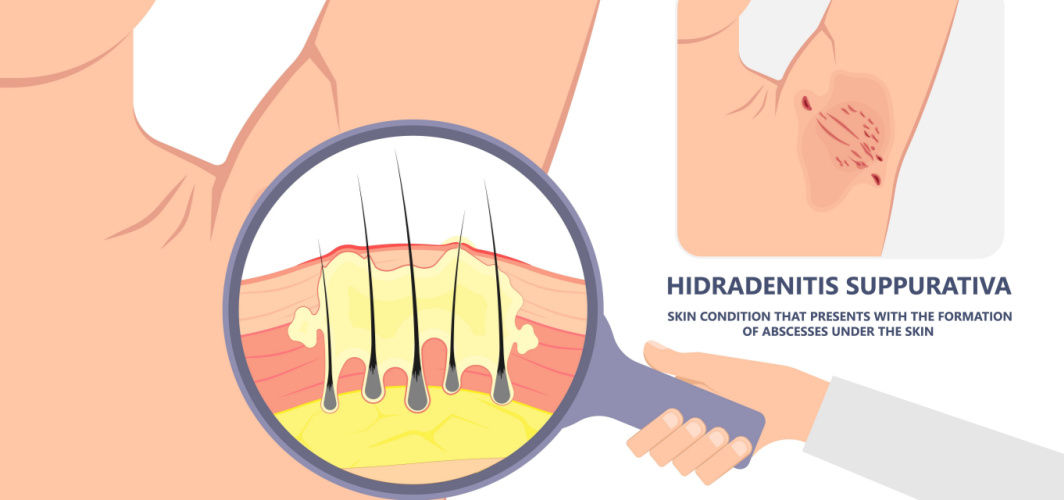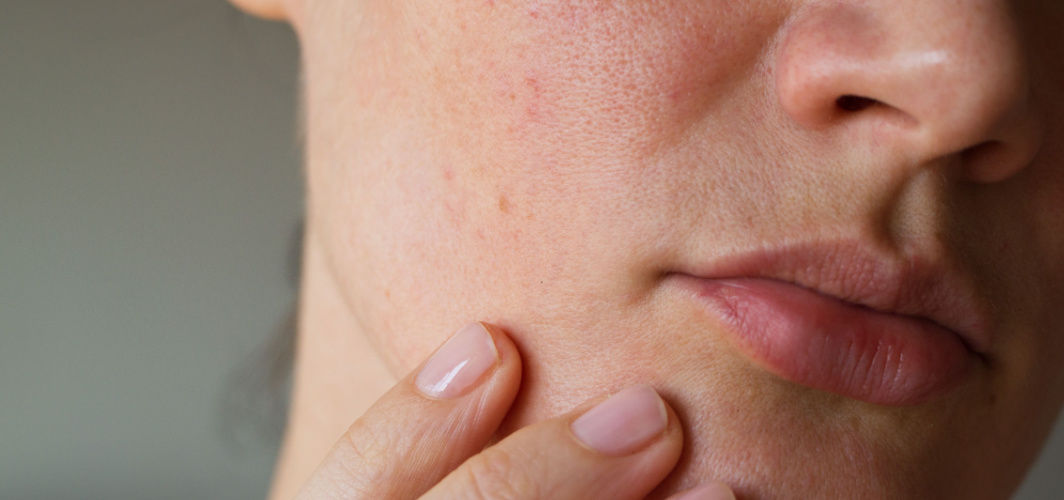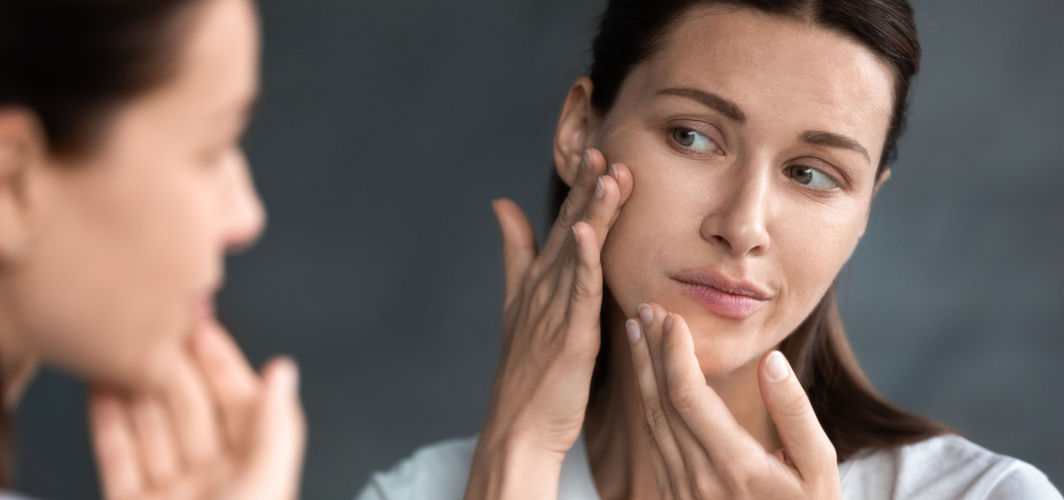Skin Care
Hidradenitis Suppurativa (HS): Definition, Causes, Triggers, Symptoms, Treatments & Prevention
11 min read
By Apollo 24|7, Published on - 06 October 2023
Share this article
0
0 like

Hidradenitis Suppurativa (HS) is a chronic inflammatory skin condition that affects the hair follicles and oil glands in certain areas of the body, such as the armpits, groin, and buttocks. It is characterised by the development of painful and recurrent abscesses, nodules, and tunnels under the skin. In this blog, we will delve into the complex world of HS disease, shedding light on its definition, underlying causes, potential triggers, symptoms, available treatments, and effective prevention strategies to provide a comprehensive understanding of this challenging condition.
What is Hidradenitis Suppurativa?
Hidradenitis Suppurativa (HS) is a chronic inflammatory skin condition that primarily affects areas with apocrine glands, such as the armpits, groin, and buttocks. It is characterised by recurrent abscesses, nodules, and sinus tracts in these affected areas.
HS starts with the blockage of hair follicles, leading to the accumulation of bacteria and inflammation. Over time, this can result in the formation of painful lesions that may take weeks or even months to heal. The severity of HS can vary from mild discomfort to debilitating pain and can significantly impact a person's quality of life.
In India, the prevalence of HS disease is estimated to be around 1% to 4% of the population. This means that millions of individuals in our country are living with this condition.
Causes and Triggers of Hidradenitis Suppurativa
In this section, we will delve into the causes and triggers of Hidradenitis Suppurativa.
1. Genetic Factors
Hidradenitis Suppurativa is believed to have a genetic component that predisposes individuals to develop the condition. Here's what you need to know about the role of genetics in HS:
- Genetic Predisposition: Studies have found that there is a higher prevalence of HS disease among family members, suggesting a genetic link. If you have a close relative with HS, you may be at a higher risk of developing the condition.
- Immune System Dysfunction: Certain genetic variations can lead to abnormalities in the immune system, making it less effective in fighting off infections and inflammatory processes. This dysfunction can contribute to the development of HS.
- Follicular Occlusion: Genetic factors can also influence the structure and function of hair follicles, leading to their occlusion or blockage. This occlusion can create an environment conducive to the formation of abscesses and subsequent inflammation.
2. Hormonal Factors
Hormonal imbalances, such as elevated androgens or hormonal fluctuations in women, have been found to play a role in the development of HS. Androgens are male hormones that are also present in females but at lower levels. When these hormone levels become imbalanced, it can trigger the inflammation and obstruction of hair follicles, leading to the formation of painful lesions in individuals predisposed to HS.
In women, hormonal fluctuations during pregnancy, menstrual cycles and menopause can also contribute to HS development. The changes in hormone levels during these times can increase sebum production and stimulate the apocrine glands, further exacerbating the condition.
3. Environmental Factors
Environmental factors can play a significant role in triggering or worsening symptoms of Hidradenitis Suppurativa (HS). These factors include:
- Smoking: Smoking can increase the risk of developing HS and make the symptoms worse. The harmful chemicals in cigarettes can lead to inflammation and damage the skin's ability to heal.
- Obesity: Excess weight puts additional pressure on the skin, leading to increased friction and sweating. This can aggravate HS symptoms and worsen inflammation.
- Exposure to Chemicals: Some chemicals found in household products or occupational environments may trigger or exacerbate HS symptoms. These include solvents, heavy metals, and certain industrial chemicals. It is crucial to identify and avoid these triggers to minimise flare-ups.
Potential Symptoms of Hidradenitis Suppurativa
In this section, we will delve into the symptoms and clinical presentation of Hidradenitis Suppurativa.
1. Common Affected Areas
While HS can manifest in various areas, there are some commonly affected regions that individuals should be aware of:
- Axillary Region: The armpits are a common site for HS development due to the abundance of hair follicles and sweat glands in this area. The presence of constant friction and moisture can exacerbate symptoms.
- Groin: The skin folds in the groin area provide an ideal environment for HS to thrive. It often presents as painful, pus-filled bumps or abscesses that can lead to scarring.
- Buttocks: The buttock region is another frequently affected area, with symptoms ranging from small, tender nodules to large, deep-seated abscesses. It can significantly impact mobility and quality of life.
- Under the Breasts: HS can also occur underneath the breasts, particularly in women with larger breasts or those who sweat excessively. The warm and moist environment may contribute to the formation of painful nodules and abscesses.
2. Stages and Symptom Progression
To understand the symptoms of HS, it is important to be aware of the different stages that this condition can progress through. The stages of HS range from mild to severe and can be categorised as follows:
- Stage 1: In this early stage, there may be occasional single or multiple small abscesses, which are tender, red bumps under the skin. These abscesses may resolve on their own or leave behind small scars.
- Stage 2: As the disease progresses, recurring abscesses become more frequent and larger in size. These abscesses may form interconnected tunnels called sinus tracts, which can lead to the development of hard, painful nodules or lumps.
- Stage 3: At this advanced stage, chronic abscesses and sinus tracts are present, often leading to widespread scarring and the formation of deep, painful nodules or cysts. The affected areas may have open wounds that do not heal easily.
3. Associated Symptoms and Complications
Some of the most common symptoms associated with Hidradenitis Suppurativa are:
- Pain: One of the most common symptoms of HS is pain. The affected areas may be tender, swollen, and painful to touch or move. The pain can range from mild discomfort to severe, debilitating pain.
- Itching: Itching is another symptom that individuals with HS may experience. This itching can be quite intense and bothersome, leading to constant scratching and further irritation of the skin.
- Foul Odour: Many individuals with HS report a foul odour coming from the affected areas. This odour is often described as being similar to that of rotten eggs or decomposing flesh. It can have a significant impact on self-esteem and quality of life.
- Restricted Mobility: As HS progresses, the affected areas can become swollen and inflamed, leading to restricted mobility. This can make it difficult for individuals to perform daily activities such as walking, sitting, or even dressing themselves.
In addition to these symptoms, there can also be potential complications associated with HS:
- Secondary Infections: Due to the open wounds and chronic inflammation associated with HS, there is an increased risk of developing secondary bacterial infections. These infections can further worsen the symptoms and require additional treatment.
- Psychological Distress: Living with HS can take a toll on an individual's mental and emotional well-being. The chronic pain, physical limitations, and social stigma associated with HS can lead to anxiety, depression, and a decreased quality of life.
Treatment Options for Hidradenitis Suppurativa
In this section, we will delve into the treatment options for Hidradenitis Suppurativa.
1. Lifestyle Modifications
While there is no cure for Hidradenitis Suppurativa (HS), there are several lifestyle modifications that can help manage the symptoms and improve your quality of life. Here are some suggestions for lifestyle modifications:
- Weight Loss: Weight management can help alleviate the strain on your affected areas and reduce inflammation. If you are overweight, consider consulting with a healthcare professional to develop a personalised weight loss plan.
- Smoking Cessation: Smoking has been shown to worsen HS symptoms and delay healing. Quitting smoking can significantly improve your condition and reduce the severity of flare-ups.
2. Topical Treatments
In addition to systemic treatments, topical therapies also play a significant role in managing Hidradenitis Suppurativa (HS). Some of them include:
- Antibacterial Washes: These cleansers contain ingredients like benzoyl peroxide or chlorhexidine, which help reduce bacterial growth and control infections. Regular use of antibacterial washes can help keep the affected areas clean and prevent flare-ups.
- Topical Antibiotics: Antibiotics in cream or gel form, such as clindamycin or erythromycin, can be prescribed by your dermatologist. These antibiotics work by inhibiting bacterial growth and reducing inflammation. Applying them to the affected areas can help control infections and minimise symptoms.
- Anti-inflammatory Creams: Topical corticosteroids or nonsteroidal anti-inflammatory drugs (NSAIDs) in cream or ointment form can help reduce inflammation and relieve pain associated with HS. These creams are usually applied to the affected areas once or twice daily, as directed by your healthcare professional.
3. Systemic Medications
Systemic medications are often used to treat HS, especially when the condition is severe or not responding to other treatments. Here are some commonly prescribed systemic medications for HS:
- Antibiotics: Tetracyclines, such as doxycycline and minocycline, are often prescribed to control bacterial overgrowth and reduce inflammation. They help in preventing new lesions from forming and can be used for long-term management.
- Hormonal Therapies: Anti-androgens, such as spironolactone or oral contraceptives containing cyproterone acetate, may be prescribed for women with HS. These medications reduce the effects of hormones that can contribute to the development of HS.
- Immunosuppressants: TNF-alpha inhibitors, such as adalimumab and infliximab, are potent immunosuppressant medications that can effectively control inflammation in moderate to severe cases of HS. They are usually administered through injections or infusions.
4. Surgical Interventions
When it comes to treating Hidradenitis Suppurativa (HS), surgical interventions can be an effective option. Here are some surgical options commonly used for HS treatment:
- Incision and Drainage of Abscesses: This procedure involves making a small incision to drain pus-filled abscesses. It provides immediate relief by reducing pain and inflammation. However, it is important to note that this is a temporary solution, as the abscesses may recur.
- Excision of Affected Areas: In more severe cases of HS, excision surgery may be recommended. This involves removing the affected skin and underlying tissue. While it can provide long-term relief, it may result in scarring and require a longer recovery period.
- Skin Grafting: In some cases, where large areas of skin are removed, skin grafting may be necessary. This involves taking healthy skin from another part of the body and transplanting it onto the surgical site.
Prevention Strategies for Hidradenitis Suppurativa
To prevent Hidradenitis Suppurativa flare-ups and minimise the impact of this condition on your daily life, implementing certain prevention strategies is crucial. By following these guidelines, you can keep your symptoms under control and improve your overall well-being.
1. Hygiene Practices
Maintaining good hygiene is essential in preventing HS flare-ups.
- Make sure to cleanse the affected areas regularly with a mild antibacterial soap to keep the skin clean and free from bacteria.
- Gently pat dry the affected areas after washing, avoiding any friction or rubbing that could aggravate the condition.
- Wearing loose-fitting clothes made of breathable fabrics can help reduce sweating and friction, which are common triggers for HS disease.
2. Dietary Considerations
When it comes to managing Hidradenitis Suppurativa (HS), making certain dietary changes can play a significant role in reducing symptoms and preventing flare-ups.
Opt for a diet that is rich in foods known for their anti-inflammatory properties. This includes consuming plenty of fruits, vegetables, whole grains, lean proteins, and healthy fats. These foods can help reduce inflammation in the body and support overall skin health.
Thankfully, the Indian diet offers a wide variety of options that can be included in an anti-inflammatory HS diet. Consider incorporating the following:
- Turmeric: Known for its powerful anti-inflammatory properties, turmeric can be added to curries, and rice dishes, or even consumed as warm turmeric milk (haldi doodh).
- Ginger: Another potent anti-inflammatory spice, ginger can be used in various dishes like soups, stir-fries, or as a tea.
- Garlic: Garlic possesses antimicrobial and anti-inflammatory properties. Add it to curries, sauces, or salad dressings.
- Leafy greens: Spinach, kale, and fenugreek leaves are packed with nutrients and can be added to curries or cooked as a side dish.
3. Stress Management
Stress has been identified as a trigger for HS flare-ups in many individuals. When you're stressed, your body releases certain hormones that can worsen inflammation and compromise your immune system. To manage stress effectively and reduce the impact on HS, consider incorporating the following techniques into your daily routine:
- Meditation: Practicing mindfulness meditation can help you relax and calm your mind, reducing stress and anxiety levels.
- Yoga: Engaging in yoga exercises can improve flexibility, promote relaxation, and relieve stress.
- Counselling: Seeking therapy or counselling can support you and coping mechanisms to better handle stressors in your life.
Conclusion
In conclusion, Hidradenitis Suppurativa is a chronic inflammatory skin condition that can significantly impact an individual's quality of life. Early diagnosis and comprehensive management are crucial in minimising symptoms and preventing complications. With ongoing research and advancements in HS treatment, there is hope for better outcomes for individuals living with this condition.
Skin Care
Consult Top Dermatologists
View AllFrequently Asked Questions
Can diet affect HS?
Can diet affect HS?
Is HS contagious?
Is HS contagious?
Can stress worsen HS?
Can stress worsen HS?
Are there any new treatments for HS?
Are there any new treatments for HS?
What are the triggers for Hidradenitis Suppurativa?
What are the triggers for Hidradenitis Suppurativa?
Leave Comment
Recommended for you

Skin Care
Ichthyosis Vulgaris: Definition, Causes, Triggers, Symptoms, Treatments & Prevention
Explore Ichthyosis Vulgaris - its definition, causes, triggers, symptoms, treatments, and prevention for a comprehensive understanding of this skin condition.

Skin Care
Worried About Premature Ageing of the Skin? Here’s What to Avoid!
Are you worried that your skin might be ageing earlier than expected? Don’t know why your skin is wrinkling and sagging? Read on to find out about the most common causes of premature ageing of the skin.

Skin Care
9 Hair Care Tips To Protect Your Locks From The Summer Heat
Summers can be challenging for hair care due to the hot and humid weather and regular exposure to the sun. The combination of these factors can lead to hair damage, dryness, split ends, and hair loss. It is important to take precautions to maintain healthy hair during the summer season.
Subscribe
Sign up for our free Health Library Daily Newsletter
Get doctor-approved health tips, news, and more.
Recommended for you

Skin Care
Ichthyosis Vulgaris: Definition, Causes, Triggers, Symptoms, Treatments & Prevention
Explore Ichthyosis Vulgaris - its definition, causes, triggers, symptoms, treatments, and prevention for a comprehensive understanding of this skin condition.

Skin Care
Worried About Premature Ageing of the Skin? Here’s What to Avoid!
Are you worried that your skin might be ageing earlier than expected? Don’t know why your skin is wrinkling and sagging? Read on to find out about the most common causes of premature ageing of the skin.

Skin Care
9 Hair Care Tips To Protect Your Locks From The Summer Heat
Summers can be challenging for hair care due to the hot and humid weather and regular exposure to the sun. The combination of these factors can lead to hair damage, dryness, split ends, and hair loss. It is important to take precautions to maintain healthy hair during the summer season.



